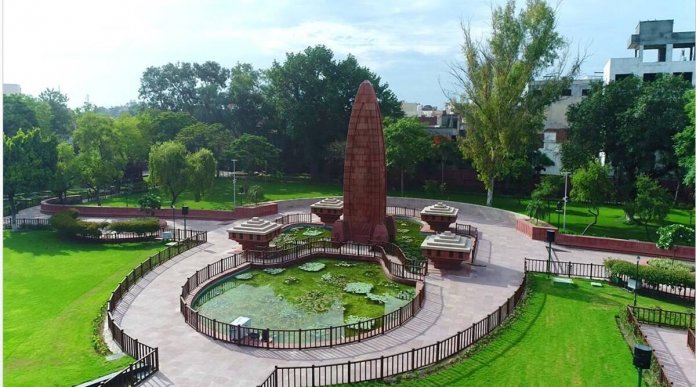Hello Readers!
We all must know about the Jallianwala Bagh massacre that happened on 13 April,1919 and the loss it caused to our country. The horrific massacre marked a turning point in the history of colonial rule. JallianwalaBagh inspired countless revolutionaries and fighters, including Sardar Udham Singh and Sardar Bhagat Singh, to die for India’s freedom.
Prime Minister Narendra Modi inaugurated the renovated complex of the Jallianwala Bagh memorial on 28 August and dedicated it to the people of the nation. The Centre alloted approximately Rs 20 crore in 2019 to commemorate the 100th anniversary of the Jallianwala Bagh massacre. The revamped memorial was to be inaugurated on April 13 this year to mark 102 years of the massacre. However it was delayed due to Covid-19 restrictions.
Key Highlights of the event
- The complex of Jallianwala Bagh Smarak was inaugurated virtually. During the event the Prime MInister also inaugurated the Museum Galleries at the Smarak.
- The event highlighted the government’s numerous development initiatives to upgrade the complex.
- A two-minute silence was observed to pay tribute to the Jallianwala Bagh martyrs. Members of the families of those killed by British bullets were present for the ceremony.
- The event was attended by the Union Minister of Culture, the Union Minister of Housing and Urban Affairs, Ministers of State for Culture, the Governor and Chief Minister of Punjab, the Chief Ministers of Haryana, Uttarakhand, and Himachal Pradesh, Lok Sabha and Rajya Sabha MPs from Punjab, and members of the Jallianwala Bagh National Memorial Trust, among others.
- Families of the Jallianwala Bagh martyrs were also invited to the event at Jallianwala Bagh in Amritsar.
Features of the Renovated Jallianwala Bagh Memorial
- The entry and exit points to the memorial have been repositioned, and a lotus pond has been constructed around the main memorial.
- The famous ‘Shahidi Khu’ or Martyrs Well, into which people jumped to escape the hail of bullets, is now surrounded by a glass shield.
- A 28-minute Sound and Light show re-enacting the events of April 13, 1919, will be shown every evening free of cost. A Salvation Ground has been constructed for visitors to sit in silence in memory of the martyrs.
- Several new martyr sculptures have appeared on the high walls of the complex’s narrow lane through which visitors enter. These are ordinary Punjabis from various walks of life who entered the park on that fateful day but never returned.
- Four new galleries have been created by reusing underutilised buildings in the complex to highlight the historical significance of events that occurred in Punjab during that time period. The galleries depict Punjab’s history, the freedom movement’s history, and the Ghadar movement.
- Also, the Flame monument, which is called the heart of the Bagh, has also been repaired and restored.
Jallianwala Bagh Massacre
The tragedy, also known as the Amritsar Massacre, exposed the British’s inhumane approach when British troops led by General Reginald Edward Dyer opened fire on an unarmed crowd.
During World War I (1914–18), the British government of India enacted a series of repressive emergency powers to combat subversive activity.
The Anarchical and Revolutionary Crimes Act of 1919, also known as the Rowlatt Act (Black Act), was passed on March 10, 1919. It authorised the government to imprison or confine anyone associated with seditious activities that caused nationwide unrest without a trial.
A crowd of at least 10,000 men, women, and children gathered in Jallianwala Bagh on April 13, 1919, to celebrate baisakhi and demand the release of Dr. Saifuddin Kitchlew and Dr. Satyapal.
The two prominent leaders, who represented Hindu-Muslim unity, organised a peaceful protest against the Rowlatt Act. They were arrested by and taken out of the city.
In response to the massive gathering, Brigadier-General Dyer immediately deployed his troops and ordered them to open fire. The park’s only exit was sealed, and indiscriminate shooting occurred, killing hundreds of innocent civilians.
Partition Horror Remembrance Day
Prime Minister Narendra Modi on 14 August 2021 declared this day to be observed as ‘Partition Horror Remembrance Day’ to acknowledge the pain inflicted among the Indians due to the partition of 1947. Pakistan celebrates 14 August as its independence day.
The day commemorates the hardships endured by many Indians during the partition. Several families were uprooted, and many people died as a result of the partition. It aims to remind Indians of the importance of removing social divisions and disharmony, as well as to strengthen the spirit of oneness, social harmony, and human empowerment.
With this we come to the end of this blog. We talked about the key features of the revamped Jallianwala Bagh Memorial and the importance of it in the freedom struggle of India.
Stay tuned on hrnaker.com for more content.




